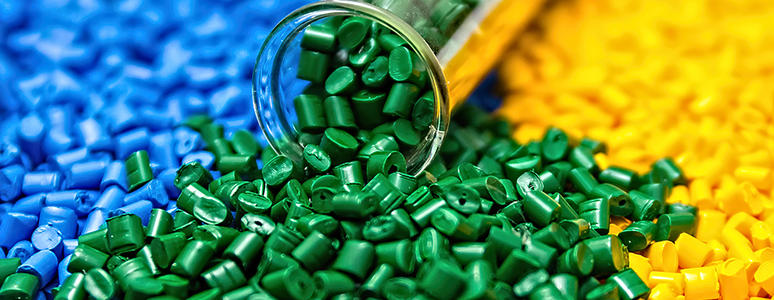Development and application of biodegradable polymer plastics, biodegradable plastics is a kind of new type with the function of degradation of polymer materials, in use process, it has to do with the same kind of common plastic with the corresponding health and relevant application performance, and after its complete function, the material can rapidly degraded in the natural environment conditions become easy to be given environment fragments or crushed, and with the passage of time further degradation become eventually oxidation products (CO2 and water), return to nature.
Development and application of biodegradable polymer plastics, biodegradable plastics is a kind of new type with the function of degradation of polymer materials, in use process, it has to do with the same kind of common plastic with the corresponding health and relevant application performance, and after its complete function, the material can rapidly degraded in the natural environment conditions become easy to be given environment fragments or crushed, and with the passage of time further degradation become eventually oxidation products (CO2 and water), return to nature.
Based on the environmental pollution caused by plastic waste, as well as the demand of environmental protection and human needs, it is urgent to study degradable polymer materials. In a specific time and under certain environmental conditions, the chemical structure of biodegradable plastics will change. According to the reasons for the changes in its chemical structure, biodegradable plastics can be divided into two categories: biodegradable plastics and photodegradable plastics.
1. Degradation mechanism of degradable plastics
Generally speaking, degradable plastic refers to a kind of plastic that can be decomposed into small molecules through the action of microorganisms in soil or solar radiation.It must meet the requirements of the use of products and easy to process on the basis of the basis of biodegradable properties. The nature of the action of sunlight on polymer materials is the comprehensive effect of ultraviolet light in sunlight and oxygen in air, so it is also called photooxidation degradation. Take polyolefin as an example to explain the mechanism of photooxidation degradation. In essence, photooxidation causes chain breaking or crosslinking of polymers, and some oxygen-containing functional groups, such as carboxylic acids, peroxides, ketones and alcohols, are formed in this process. Catalyst residues in polymers and initiation of peroxide and carboxyl groups introduced during processing are the main sources of degradation.
Under the action of microorganisms (mainly fungi, bacteria or algae, etc.), polymers can be eroded or metabolized to cause changes in their chemical structure and decrease in molecular weight. The mechanism of action can be mainly divided into two situations :
(1) biophysical action. That is, after the erosion of plastic products by microorganisms, biological cells growth, promote the decomposition of polymers, ionization or proton, this physical action on the polymer caused mechanical damage, the high molecular weight of the polymer into oligomer fragments, so as to achieve the purpose of physical degradation.
(2) biochemical action — direct action of enzymes. This situation is caused by the erosion of enzymes secreted by fungi or bacteria, which leads to the splitting or oxidative disintegration of plastics, and causes the splitting or oxidative degradation of insoluble polymers into water-soluble fragments, generating new small molecular compounds (CH4, CO2 and H2O) until the final decomposition.
There are generally two hypotheses about the mechanism of biodegradation of polymer materials that lead to biodegradation. The other is an invasive cut from the end of the chain. Therefore, the structural properties of materials, such as composition, main and side chain structure, size of end groups, and presence or absence of spatial steric resistance, are the key factors affecting their degradation performance. Among them, the main chain properties have a greater impact. If the main chain of the polymer contains bonds that are easily hydrolyzed, it will be easily biodegraded. Secondly, if the backbone is flexible, the degradation rate will be relatively fast, whereas if the backbone is rigid and orderly, the degradation rate will be slow.
The biodegradability of polymer materials is reduced by branching and crosslinking. For example, the introduction of hydrophobic groups at the end of polylactic acid (PLA) molecular chain can reduce the erosion rate at the initial stage of degradation. This is because in the original degradation process, PLA’s erosion mainly depends on the structure of molecular chain end, and the addition of hydrophobic groups leads to the decline of its erosion rate. In addition, some researchers have studied the chemical structure of polymers and the relative molecular weight of materials that play an important role in their degradation.
2. Development of biodegradable plastics
The development direction of biodegradable plastics in the future can be as follows:
(1) biodegradable plastics were prepared by studying the biodegradation mechanism of degradable polymers, and the block copolymerization of biodegradable plastics with existing ordinary polymers, microbial polymers and natural polymers was studied and developed.
(2) to search for microorganisms that can produce polymer plastics, explore new polymers, analyze their synthesis mechanism in detail, improve their productivity through existing methods and genetic engineering methods, and study efficient methods of cultivating microorganisms.
(3) pay attention to the control of degradation rate, develop efficient degradation promoters and stabilizers to improve the biodegradation performance of degradable plastics, reduce their cost, and expand the market application.
(4) research and establish a unified definition of degradable plastics, enrich and improve the evaluation method of biodegradation, and further understand the degradation mechanism.

Post time: Aug-13-2019

